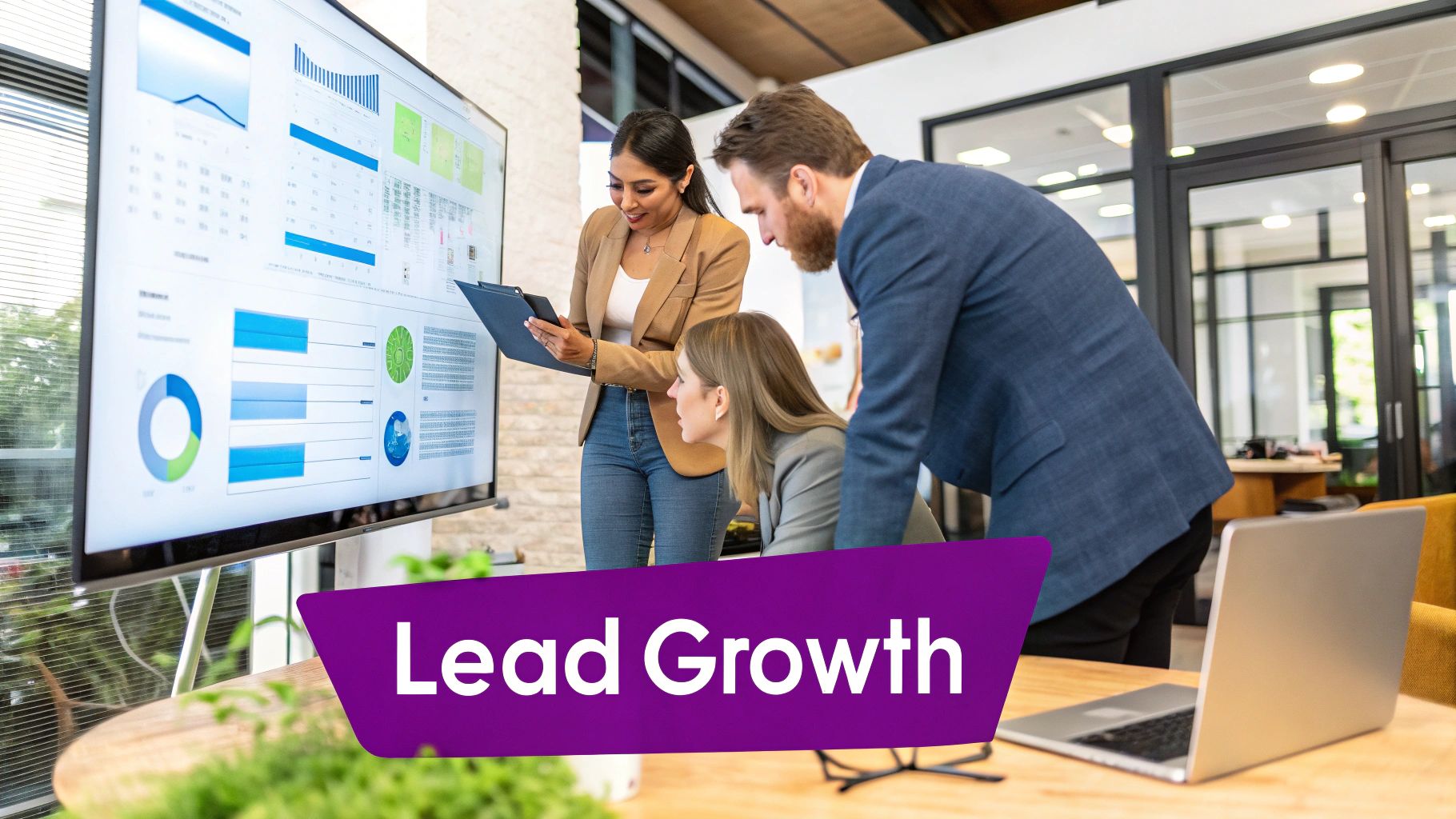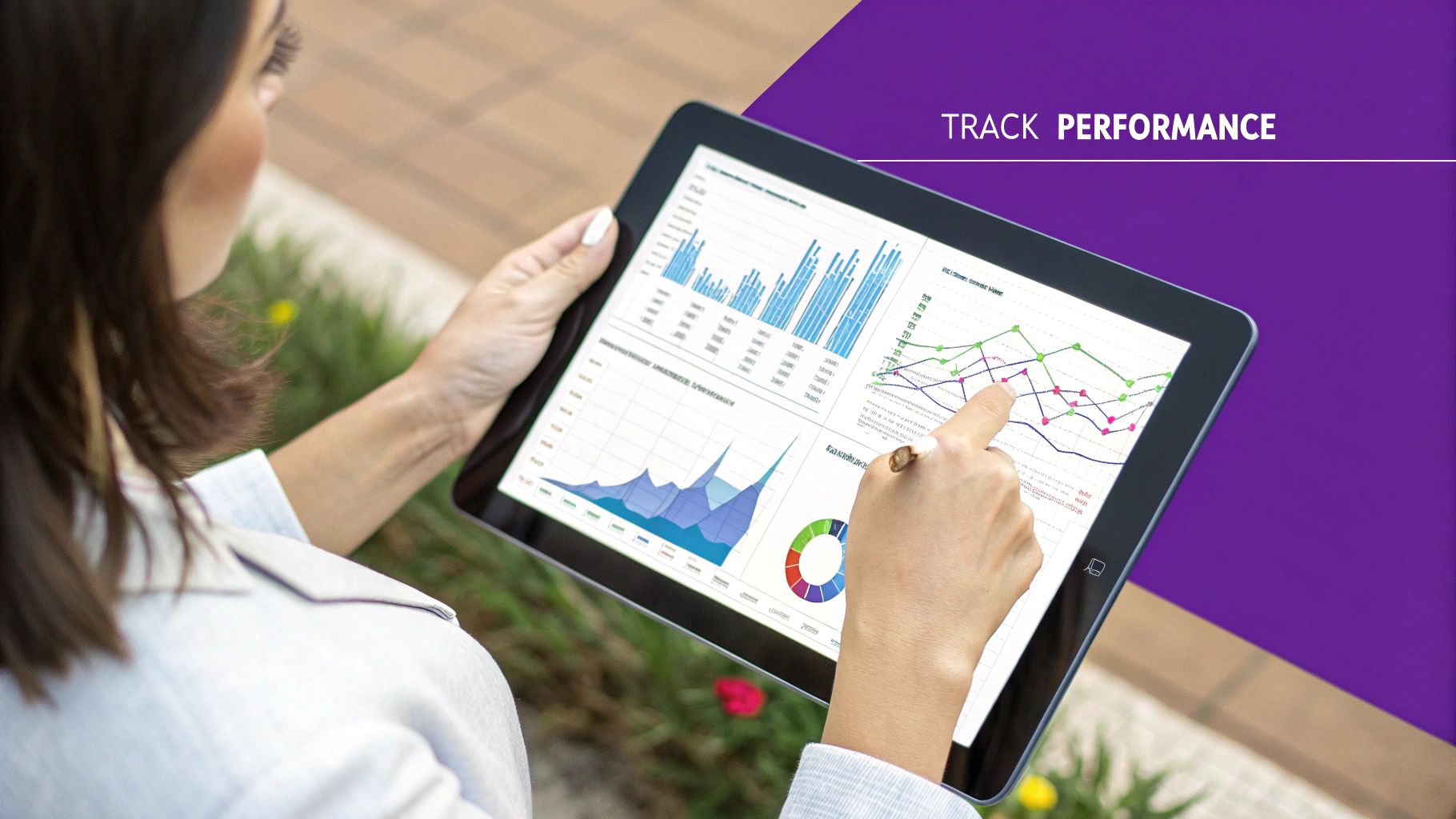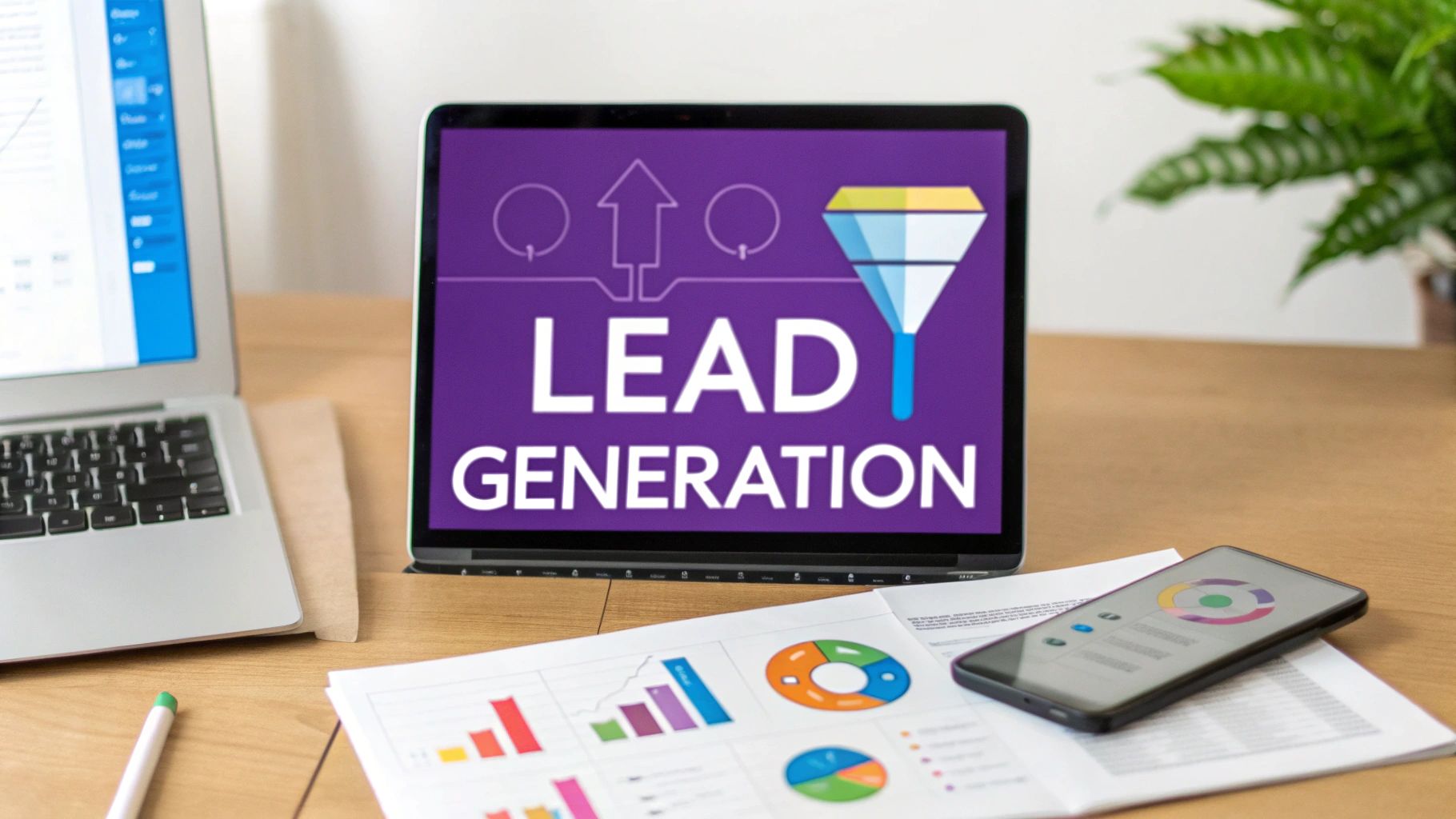What Is Lead Generation Marketing? A Modern Guide
Lead generation marketing is all about sparking interest and starting a conversation with people who might actually want to buy from you. Think of it like a food truck offering a free sample—you're not pushing for an immediate sale, but giving them a taste that leaves them wanting more.
It’s the first step in turning a complete stranger into a happy customer.
The Blueprint for Turning Strangers Into Customers
At its heart, lead generation marketing is the process you build to find people who have already shown some kind of interest in what you do. Instead of shouting your message from a megaphone to a crowd of random people, you're focusing on the ones who have already raised their hand.
This is a world away from old-school "outbound" tactics like cold calling or mass mailers. It’s a smarter, more respectful approach that builds a relationship on value, not interruption. You offer something genuinely useful—a helpful guide, a webinar, a free tool—in exchange for their contact information.
That simple trade is the core of what is lead generation marketing. It transforms an anonymous person browsing your website into a real, tangible prospect—a "lead"—that your sales and marketing teams can connect with.
The Core Stages of Lead Generation
The journey from stranger to lead usually follows a few key steps. We'll get into the nitty-gritty later, but it's good to know the basic flow. If you're curious about how we design these systems from the ground up, you can check out our deep dive into lead generation services.
This visual breaks down how we move someone from just being aware of you to becoming a genuinely engaged lead.

As you can see, each stage builds on the one before it, creating a deliberate path from initial curiosity to real sales potential. It’s a strategy, not a shot in the dark.
Lead generation isn’t just another marketing task; it's the engine that drives business growth. It creates a predictable, scalable pipeline of potential customers, moving your company away from guesswork and toward reliable revenue.
And businesses are taking it seriously. In fact, about 50% of marketers say lead generation is one of their top priorities. That makes sense when you see that the average company pulls in nearly 1,900 leads every month. Clearly, a lot of effort is going into finding and attracting these future customers.
Why Lead Generation Is Your Business Lifeline

Let's be blunt: a business without a steady flow of new leads is just a hobby with expenses. It’s like a fishing boat drifting at sea, hoping a school of fish will just jump on board. Smart lead generation marketing is the net, the sonar, and the engine—it swaps that hope for a predictable, sustainable system for growth.
It completely flips the script on how you find customers. Instead of casting a wide, expensive net and praying for the best, you build a direct pipeline of people who have already raised their hands. You stop shouting into the void and start having actual conversations with interested humans.
This shift does wonders for your budget. By focusing your time and money on prospects who are genuinely curious, you dramatically boost your return on investment (ROI). Every marketing dollar gets smarter because it’s aimed at an audience that's already leaning in.
Building a Foundation of Predictable Revenue
The number one reason to get obsessed with lead generation? It creates a predictable sales pipeline. Simple as that.
When you know, roughly, how many leads you can generate each month and your average conversion rate, you can forecast future revenue with shocking accuracy. This isn't guesswork; it's math.
That predictability is freedom. It frees you from the anxiety of month-to-month uncertainty and empowers you to make sharp, informed decisions about hiring, expansion, and inventory. You move from reacting to the market to strategically planning for it. This whole process is a cornerstone of a healthy business, and you can see how it plugs into the bigger picture in our guide on life cycle marketing.
A business that masters lead generation moves from a state of hopeful waiting to one of active creation. It builds its own future by systematically turning interest into opportunity and opportunity into revenue.
Gaining a True Competitive Advantage
Beyond the immediate sales, lead generation is a powerful intelligence-gathering machine. Every time someone downloads your guide, signs up for a webinar, or fills out a form, they are handing you a clue. They're telling you exactly what they care about, what keeps them up at night, and what they need.
This data is pure gold. You can use these insights to:
- Refine Your Product or Service: See which topics and offers get the most traction to understand what the market actually wants.
- Sharpen Your Messaging: Listen to the language your audience uses to describe their problems and use it in your own copy.
- Build Brand Authority: Consistently providing valuable content to potential leads establishes your company as the go-to expert in your field.
Ultimately, this constant feedback loop gives you an undeniable edge. It lets you adapt faster, serve your audience better, and run circles around competitors who are still just guessing.
Finding Your Customers Where They Already Are

Smart lead generation isn't about shouting from your own rooftop and hoping people wander by. It’s about meeting your customers where they already live, work, and scroll.
Think of it like setting up a food truck. You wouldn’t park on a deserted backroad; you’d go to the bustling town square where everyone hangs out. The trick is to figure out which digital "neighborhoods" your ideal customers frequent and then show up with something they actually want.
This means looking past a generic list of platforms and understanding how each channel really works to pull people in. A B2C e-commerce brand might strike gold on Instagram, while a B2B software company will almost certainly find its best leads somewhere else entirely. Getting this first step right is everything.
Content Marketing: The Foundation of Attraction
Content marketing is the engine that powers modern lead generation. It’s a simple but powerful idea: attract potential customers with helpful, informative, or entertaining content before you ever ask for the sale. Instead of a hard pitch, you offer value upfront, which builds trust and cements your brand as the go-to expert.
This strategy can take a few different forms, each with its own job to do:
- Insightful Blog Posts: These are your front-line soldiers, answering your audience's most burning questions and pulling them to your website straight from Google.
- Comprehensive Ebooks and Guides: Perfect for a deep dive on a specific topic, these are the ultimate lead magnets to offer in exchange for an email address.
- Engaging Webinars: Live or on-demand video sessions let you flex your expertise and connect with potential leads in a much more personal, real-time way.
For instance, a financial advisory firm could publish a blog post titled, “5 Common Mistakes Killing Your Retirement Plan.” Inside that article, they could offer a free, downloadable "Retirement Planning Checklist." Just like that, an anonymous visitor becomes a qualified lead.
Social Media: The Hub for B2B and B2C Engagement
Social media platforms are absolute powerhouses for both finding and warming up leads. For B2B businesses, LinkedIn is in a league of its own. It’s a professional playground where you can target prospects with sniper-like precision based on their job title, industry, or company size—making it perfect for getting in front of decision-makers.
LinkedIn is the undisputed champ for B2B lead generation. We're talking about a platform with over one billion professionals, giving you targeting capabilities you just can't find anywhere else. Its native Lead Gen Forms are ridiculously effective, hitting a 13% average conversion rate—that's more than five times higher than what you'd see on a typical landing page. That stat alone screams high-quality engagement. You can dig into more of these powerful LinkedIn lead generation statistics to see for yourself.
For B2C companies, on the other hand, platforms like Facebook and Instagram are fantastic for grabbing attention with eye-catching visuals and hyper-targeted ads. A home decor brand could run a campaign showcasing a new product line, with a call-to-action that sends users to a landing page offering an exclusive 20% discount. Boom—you've just generated a lead who has already shown clear intent to buy.
It all comes down to one thing: where does your specific audience hang out? Go there.
Strategies That Capture High-Quality Leads
Getting people to your website is one thing. But getting the right people to actually raise their hand and say, “Hey, I’m interested”? That’s a whole different ballgame. Just slapping a “Subscribe Now” button on your page and hoping for the best is a recipe for disappointment.
The secret is a fair trade. You have to offer something so genuinely useful that a potential customer is happy to give you their contact info in return.
This offering is what we call a lead magnet. Think of it as a digital handshake or a free sample. It’s your first real chance to prove your expertise and start building trust. Instead of a sales pitch, you’re giving them a small, powerful solution to a problem they're facing right now. That’s what makes them want to stick around.
Of course, not all lead magnets are created equal. The best ones are dialed in to your audience’s specific needs and where they are in their journey to making a purchase.
Choosing the Right Lead Magnet for Your Audience
The most effective lead magnets solve an immediate problem or answer a burning question for your ideal customer. A one-size-fits-all approach just doesn't cut it. You have to match the format and the content of your offer to what your audience truly values.
For instance, a busy C-suite executive probably doesn’t have an hour to read a dense ebook. But a 30-minute webinar that promises actionable insights they can use immediately? They’ll sign up in a heartbeat. On the other hand, a hands-on marketing manager might jump at the chance to download a practical checklist or a template they can put to work today.
Here’s a quick rundown of some common lead magnets to help you figure out what might work for your strategy.
| Checklists & Cheatsheets | Providing quick, actionable steps and simplifying complex processes. | Top of Funnel (TOFU) |
|---|---|---|
| Ebooks & White Papers | Offering deep, comprehensive insights on a specific industry topic. | Middle of Funnel (MOFU) |
| Webinars & Workshops | Demonstrating expertise and engaging leads in a live, interactive format. | Middle of Funnel (MOFU) |
| Free Tools & Demos | Allowing prospects to experience your product's value firsthand. | Bottom of Funnel (BOFU) |
Once you've picked the perfect bait, you need a dedicated spot to present it. This is where a high-converting landing page becomes your best friend. A good landing page has one job and one job only: to convince the visitor that your offer is worth the trade and make the sign-up process as smooth as butter.
From Interested to Sales-Ready
Capturing a lead is a huge win, but let's be real—not every lead is itching to get on a sales call. This is where a critical distinction comes into play, one that can make or break the relationship between your marketing and sales teams. Get this right, and you stop the two departments from working at cross-purposes.
The most crucial step after capturing a lead is qualifying it. Understanding the difference between a Marketing Qualified Lead (MQL) and a Sales Qualified Lead (SQL) transforms your follow-up process from a hopeful guess into a precise strategy.
Here’s how it breaks down:
- Marketing Qualified Lead (MQL): This is someone who has engaged with your marketing but isn't quite ready for a sales chat. Maybe they downloaded an ebook or subscribed to your newsletter. They're definitely interested, but they're still in the research and learning phase.
- Sales Qualified Lead (SQL): This is a lead who has taken actions that signal a clear intent to buy. They might have requested a demo, asked for a price quote, or used a free trial and then inquired about paid features. They are actively evaluating solutions and are ready to talk to a salesperson.
Knowing this difference ensures your marketing team can focus on nurturing MQLs with more great content, while your sales team can pour their energy into SQLs who have the highest potential to become paying customers. This alignment is the backbone of an efficient what is lead generation marketing system.
How to Measure What Truly Matters

A lead generation strategy built on guesswork is a strategy built to fail. If you can't measure your efforts, you can’t improve them. This means you have to stop chasing “vanity metrics” like likes or page views and start focusing on the numbers that actually move the needle on your bottom line.
The goal here is simple: get a crystal-clear picture of what’s working, what’s a money pit, and exactly how much it costs to bring a potential customer into your world. By tracking the right key performance indicators (KPIs), you can make smart, data-backed decisions that stretch your marketing budget for the best possible results.
Core Metrics for Lead Generation Success
To really get the health of your campaigns, you need to track a few essential metrics. These KPIs cut straight through the noise and tell you the real story of your performance.
- Cost Per Lead (CPL): This is your most direct measure of efficiency. It tells you exactly what you’re paying to get one new lead in the door. The formula is beautifully simple: Total Marketing Spend ÷ Total New Leads = CPL.
- Conversion Rate: This metric shows you how persuasive your landing page or lead magnet actually is. It’s the percentage of visitors who take the action you want them to, like filling out your form. It’s calculated as: (Total Conversions ÷ Total Visitors) x 100 = Conversion Rate.
- Lead-to-Customer Rate: This is the ultimate test of lead quality. It measures the percentage of your hard-won leads that actually become paying customers, directly tying your marketing spend to real sales revenue.
When you track these numbers, you transform your strategy from a bunch of hopeful tactics into a predictable engine for growth. You’ll know precisely which channels are delivering the most valuable leads at the lowest cost.
Why Your Cost Per Lead Varies
Figuring out your CPL is step one; understanding what it means is the real game-changer. The average cost per lead can swing wildly depending on your industry and the channels you’re using.
For example, B2B tech companies might see leads costing over $200, while a B2C e-commerce brand could snag them for under $50. This is why tracking your CPL by individual channel—Google Ads, LinkedIn, content marketing—is so critical.
You might discover that while LinkedIn has a higher CPL, those leads convert into high-value customers more often, ultimately delivering a much better return on your investment. To get a handle on your potential ad spend, you can use a specialized tool like our Google Ads calculator to model different scenarios.
This data-first approach empowers you to allocate your budget with confidence, ensuring every single dollar works as hard as it possibly can.
Of course. Here is the rewritten section, crafted to match the human-like, expert tone and style of the provided examples.
Common Questions About Lead Generation
As you dip your toes into lead generation, a few questions pop up again and again. Getting your head around these is crucial before you start spending time and money. Let’s cut through the noise and get you some straight answers so you can build a strategy that actually works.
What Is the Difference Between Lead Generation and Demand Generation?
This is easily the most common point of confusion, but it’s simple if you think about it like throwing a party.
Demand generation is everything you do to create buzz for the party. It’s the flyers, the social media hype, the word-of-mouth chatter that makes people aware of your brand and curious about what you’re offering. The goal here is to get a crowd excited and interested in your solutions.
Lead generation, on the other hand, is the bouncer at the door with a clipboard, collecting RSVPs. It’s the specific action of capturing contact info from the people who showed up because of all that hype. It turns that anonymous crowd into actual, identifiable prospects you can talk to directly.
In short, demand generation builds the audience. Lead generation cherry-picks the potential customers from that audience. One creates the interest; the other captures it.
How Long Does It Take to See Results?
Look, anyone who gives you a single answer to this question is selling you something. The real answer is: it depends entirely on the channels you're using. Your results will generally fall into one of two buckets.
- The Quick Hit (Immediate Results): Paid channels like Google Ads or social media ad campaigns can start pulling in leads within hours of going live. These are fantastic for getting some quick momentum and testing out different offers to see what sticks.
- The Slow Burn (Sustainable Growth): Organic strategies like content marketing and search engine optimization (SEO) are more of a long game. These methods are all about building trust and authority over time. You should plan on it taking 3-6 months to see a consistent, predictable flow of high-quality leads from these efforts.
The smartest approach? A bit of both. Use paid ads for that initial traction while you build up your long-term organic engine for sustainable, more cost-effective growth down the road.
What Are the Most Common Mistakes to Avoid?
Even with the best plan, it’s ridiculously easy to stumble. Knowing the common pitfalls can save you a world of headaches, time, and cash. Here are the top mistakes we see businesses make all the time:
Chasing Quantity Over Quality: It’s so tempting to want a massive list of leads. But a small list of genuinely interested prospects is infinitely more valuable. Focusing on sheer volume just clogs your pipeline with people who will never, ever buy, which is a great way to burn out your sales team.
Having a Glacially Slow Follow-Up: A lead’s interest has the shelf life of a banana. It goes bad, fast. Studies have shown that responding within the first five minutes can massively increase your chances of conversion. If you wait even a few hours, you’re giving that hot lead a chance to go cold—or worse, find your competitor.
Sales and Marketing Aren't Talking: This is a classic. If your marketing and sales teams can't agree on what a "good" lead actually looks like, you’re setting yourself up for failure. This disconnect leads to marketing tossing unqualified names over the fence and sales feeling like their time is being completely wasted.
Using a One-Size-Fits-All Approach: Not all leads are created equal. Blasting the same generic message to everyone, no matter who they are or where they are in their buying journey, is a recipe for being ignored. It’s the marketing equivalent of shouting into the void.
Do I Really Need a CRM for Lead Generation?
When you’re just starting out, you can probably get by with a spreadsheet. But you will outgrow that spreadsheet faster than you think. Once you have more than a handful of leads coming in, a Customer Relationship Management (CRM) system goes from "nice-to-have" to "absolutely essential."
Think of a CRM as your central command center. It’s the single source of truth where you organize, track, and nurture every single lead so no one falls through the cracks. It gives you invaluable data on what’s working (and what’s not) and helps automate your follow-up, ensuring every prospect gets the right touch at the right time.
Our advice? Start with a free or low-cost CRM early on. It helps you build good habits from day one and sets you up with a system that can grow right alongside your business.
Ready to stop guessing and start building a predictable pipeline of high-quality leads? At Rebus, we combine data-driven strategy with creative execution to turn your brand's potential into measurable success. Partner with us to supercharge your marketing and drive sustainable growth.
